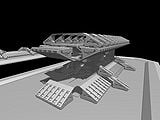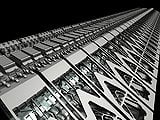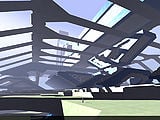Forerunner City: Difference between revisions
From Halopedia, the Halo wiki
No edit summary |
No edit summary |
||
| Line 1: | Line 1: | ||
{{Era|RW}} | {{Era|RW}} | ||
[[File:CartographerRough.jpg|thumb| | [[File:CartographerRough.jpg|thumb|300px|An exterior view of the city's final iteration. This design was recycled for the [[Cartographer]] in ''[[Halo 3]]''.]] | ||
'''"The Lost City"''' was a concept for a gameplay space to be featured in ''[[Halo 3]]''. However, it was cut during development, as the space had grown so immense that ''"it could be a game in itself"''.<ref>[https://picasaweb.google.com/114253662089061571624/Halo3TheLostCity#5573889624080394914 '''Picasa''': ''Paul Russel > Halo 3: The Lost City 12/16'']</ref> | |||
'''"The Lost City"''' was a concept for a gameplay space to be featured in ''[[Halo 3]]''. However, it was cut during development, as the space had grown so immense that ''"it could be a game in itself"''.<ref>[https://picasaweb.google.com/114253662089061571624/Halo3TheLostCity#5573889624080394914 '''Picasa''': ''Paul Russel > Halo 3: The Lost City 12/16'']</ref> | |||
The last redesign's exterior was recycled and eventually became the final game's [[Cartographer]]: the forward half of the City, especially its spire, is virtually identical to the map room. One of the two other design interations was reused in the ''[[Halo Legends]]'' episode ''[[Origins]]''. | |||
==Development and design== | ==Development and design== | ||
Built by [[Bungie]] Environmental Artist [[Paul Russel]], the level was to be based around a massive [[Forerunner]] city. At first, Russel started exploring the idea by designing different types of skyscrapers based on | Built by [[Bungie]] Environmental Artist [[Paul Russel]], the level was to be based around a massive [[Forerunner]] city. At first, Russel started exploring the idea by designing different types of skyscrapers based on Forerunner aesthetic,<ref>[https://picasaweb.google.com/114253662089061571624/Halo3TheLostCity#5573888036062396482 '''Picasa''': ''Paul Russel > Halo 3: The Lost City 1/16'']</ref> gradually adding detail until discarding the idea of a conventional, [[human]]-like city in favor of a more solid and defined arcology design.<ref>[https://picasaweb.google.com/114253662089061571624/Halo3TheLostCity#5573888865959432162 '''Picasa''': ''Paul Russel > Halo 3: The Lost City 4/16'']</ref> | ||
Russel then built several architectural components, stacking them together to form a single, massive structure which he then flipped on top of itself.<ref>[https://picasaweb.google.com/114253662089061571624/Halo3TheLostCity#5573888866357261762 '''Picasa''': ''Paul Russel > Halo 3: The Lost City 5/16'']</ref><ref>[https://picasaweb.google.com/114253662089061571624/Halo3TheLostCity#5573888867283810610 '''Picasa''': ''Paul Russel > Halo 3: The Lost City 6/16'']</ref> | |||
However, this design was also discarded and replaced by a single building covered in an ornate, extremely detailed cantilever pattern.<ref>[https://picasaweb.google.com/114253662089061571624/Halo3TheLostCity#5573888037248363522 '''Picasa''': ''Paul Russel > Halo 3: The Lost City 7/16'']</ref> The final design incorporated a variation of the repetitive cantilever structure based around a massive arcology structure, featuring an expansive interior space with complex structural elements nestled within the superstructure.<ref>[https://picasaweb.google.com/114253662089061571624/Halo3TheLostCity#5573888872495643506 '''Picasa''': ''Paul Russel > Halo 3: The Lost City 10/16'']</ref> | |||
{{Deletemat}} | {{Deletemat}} | ||
Revision as of 18:10, November 9, 2011
"The Lost City" was a concept for a gameplay space to be featured in Halo 3. However, it was cut during development, as the space had grown so immense that "it could be a game in itself".[1]
The last redesign's exterior was recycled and eventually became the final game's Cartographer: the forward half of the City, especially its spire, is virtually identical to the map room. One of the two other design interations was reused in the Halo Legends episode Origins.
Development and design
Built by Bungie Environmental Artist Paul Russel, the level was to be based around a massive Forerunner city. At first, Russel started exploring the idea by designing different types of skyscrapers based on Forerunner aesthetic,[2] gradually adding detail until discarding the idea of a conventional, human-like city in favor of a more solid and defined arcology design.[3]
Russel then built several architectural components, stacking them together to form a single, massive structure which he then flipped on top of itself.[4][5]
However, this design was also discarded and replaced by a single building covered in an ornate, extremely detailed cantilever pattern.[6] The final design incorporated a variation of the repetitive cantilever structure based around a massive arcology structure, featuring an expansive interior space with complex structural elements nestled within the superstructure.[7]
Gallery
Sources
- ^ Picasa: Paul Russel > Halo 3: The Lost City 12/16
- ^ Picasa: Paul Russel > Halo 3: The Lost City 1/16
- ^ Picasa: Paul Russel > Halo 3: The Lost City 4/16
- ^ Picasa: Paul Russel > Halo 3: The Lost City 5/16
- ^ Picasa: Paul Russel > Halo 3: The Lost City 6/16
- ^ Picasa: Paul Russel > Halo 3: The Lost City 7/16
- ^ Picasa: Paul Russel > Halo 3: The Lost City 10/16




